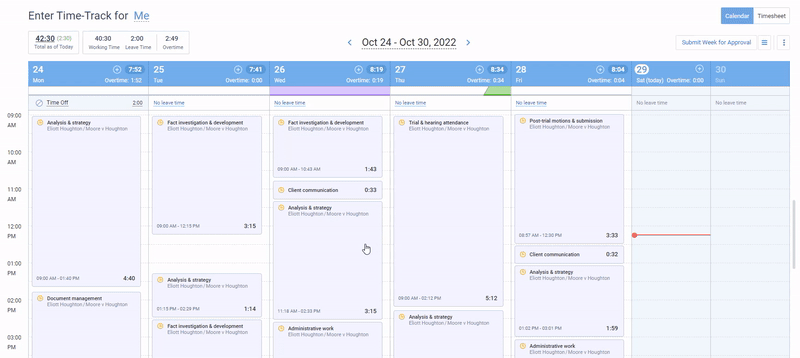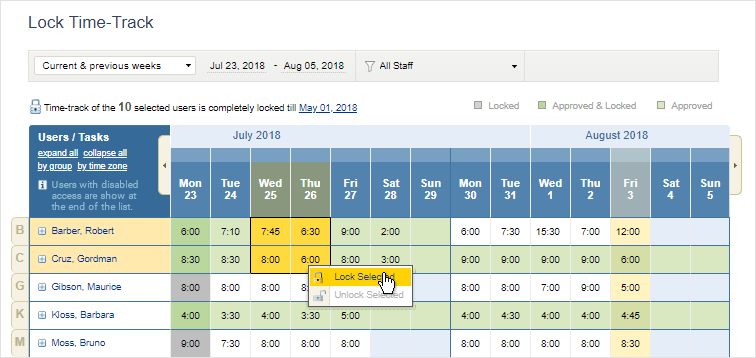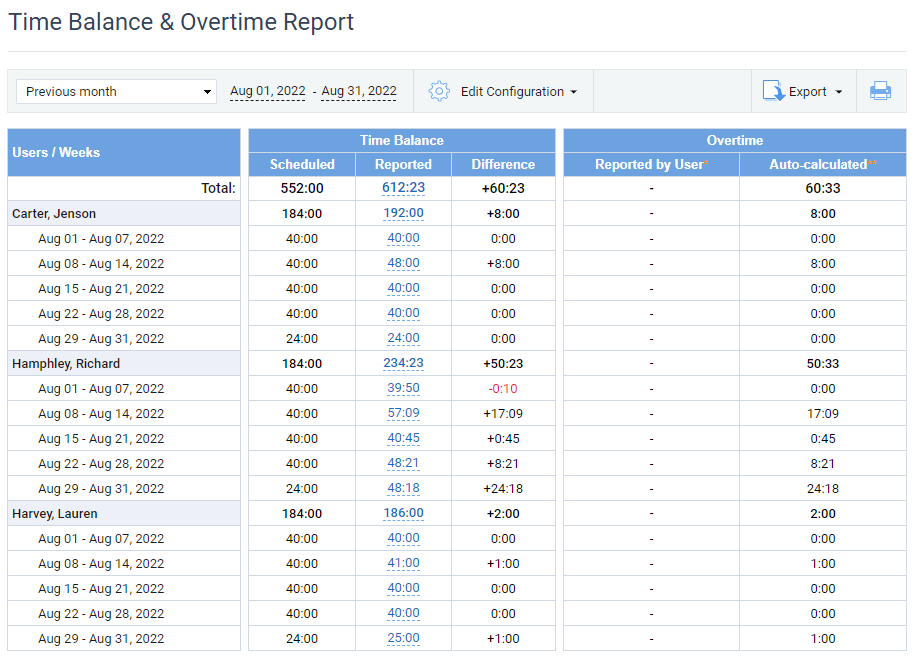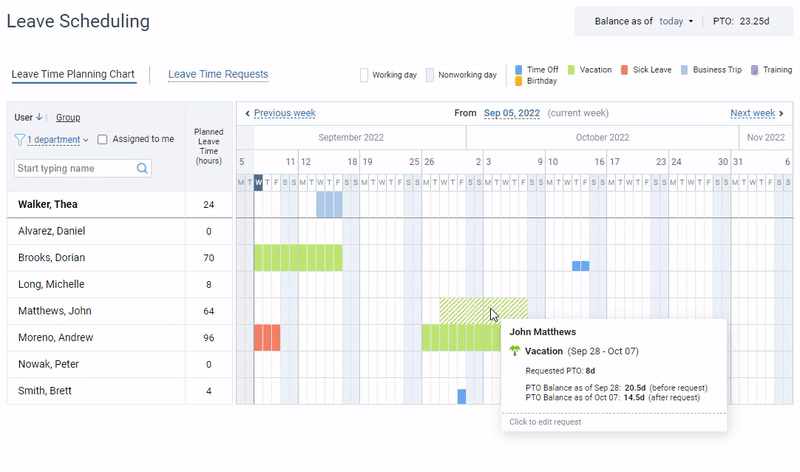
Have you ever had suspicions about your employees exaggerating their working hours? Timesheet fraud is an unfortunate reality that many businesses face, and it can have significant detrimental effects on your bottom line.
In this blog post, we’re going to delve into the world of timesheet fraud, uncover its dangers, and most importantly, provide you with foolproof strategies to protect your business from falling victim to this deceitful practice.
Let’s get started!
What Is Timesheet Fraud?
Time fraud takes place when an employee gets paid for work they never did or for time spent on activities not related to work. Time fraud schemes mostly depend on the method employees use to track their time, absences, and overtime.
The Cost of Timesheet Fraud
The consequences of timesheet fraud can be severe. It isn’t just a sign of poor ethics and mistrust between employers and their employees, but it can also affect the company’s bottom line. It results in wrong billable and payable amounts, inaccurate estimates for future workloads, as well as weak discipline and employee morale.
For example, a fraud case in Port Elizabeth, New Jersey involved more than one person. The main accused illegally acquired an amount worth $500,000 annually while showing up at work just 8 hours per week. To make this happen, his coworkers submitted false timesheets for him.
According to the Association of Certified Fraud Examiners, just one case of occupational fraud may cost a business $1.5 million on average (Source). And the problem is very widespread – an estimated 75% of businesses lose money because of buddy punching alone (Source). Add other types of timesheet fraud to the picture and the cost of the problem increases to staggering numbers.
It’s estimated that employees steal around 4.5 hours per week from their employers (Source), and based on the info by the American Payroll Association, a business loses up to 7% of its gross annual payroll because of that (Source).
Now, let’s do the math:
If we assume the employee is making $15 per hour, then the total loss per week would be $67.50 ($15 x 4.5). Multiply that by 52 weeks in a year and the total loss adds up to a whopping $3,510! And that’s just for one employee. Imagine if you have multiple employees stealing hours each week. That could really put a dent in your company’s profits.
7 Types of Timesheet Fraud
1. Inflating work hours
Essentially, this means an employee is exaggerating how many hours they’ve worked in order to get paid for time they didn’t actually put in. This can be done by adding extra time to their timesheet, or by clocking in / out cheating (i.e., punching in early or out late). For example, if an employee clocks in at 9 AM but doesn’t start working until 10 AM, they’re inflating their work hours by an hour.
Pro tip:
Timesheet errors are not always deliberate and can take place by accident. One effective method to reduce their occurrence is by using a fully automated time tracker like Time Management Assistant.
This handy browser extension keeps an accurate track of every second you spend online. It also features charts and reports that provide insight into personal productivity and can be seamlessly integrated with actiTIME, a multifunctional time tracking solution, so you don’t have to fill out your timesheets manually ever again.

Forget about manual time tracking and get precise progress data with Time Management Assistant
2. Buddy punching
Buddy punching is when an employee asks a friend (aka “buddy”) to punch them in or out when they’re not actually at work. This can be especially tempting for employees to do when they are running late or want to leave early.
Pro tip:
One of the best ways to prevent buddy punching in its tracks is to invest in a time and attendance system that is hard to manipulate. Biometric scanners or facial recognition software can help you do that.
Explore some of the best time clock solutions on the market here 👈
3. Longer break time
Some employees might think that taking an extended break is just harmless relaxation, but in reality, it’s nothing less than time theft.
If an employee takes an extra half hour for their lunch break every day, that’s 2.5 hours a week, or about 10 hours a month. Over a year, that’s over 120 hours of time that the employer is paying for but not getting any work out of. And if one employee is doing it, you can bet that others will start to follow suit. It creates a culture of laziness and entitlement that can be hard to shake.
Pro tip:
actiTIME features the Calendar View that lets you see when employees started and finished working on tasks during the day. It helps to keep overtime hours in check and track the exact time everyone spends on breaks.
Just create a task that would represent daily breaks from work and instruct employees to log time for that task in their calendars. This will encourage your team members to pay more attention to how much time they actually spend on breaks and enable you to be in better control of resources.

Track the exact time employees start and stop to work on their tasks during the day using actiTIME’s Calendar View
4. Editing timesheets retrospectively
When we say that someone is editing their timesheet retrospectively, we mean that they are going back over their recorded hours and changing them after the fact. Such an activity is a way of gaming the system as it can create a false record of the hours worked.
When an employee can go back and adjust their hours, they can potentially receive more pay than they actually earned, which is especially concerning if the employee is doing so on a regular basis.
Pro tip:
Timesheet locking prevents employees from adjusting their recorded hours without permission once they’ve already submitted them. This way, you can be sure that the hours your employees are claiming are accurate and that they’re not sneaking in any extra time.

actiTIME lets you lock timesheets in a few simple clicks to prevent employees from editing their records retrospectively
5. Unauthorized overtime
This type of fraud can occur when an employee manually adds hours to their timesheet that they did not actually work, or when they perform work outside of their authorized schedule without prior approval.
So, why is it a problem?
For starters, it can throw a company’s expenses way out of whack. If employees are clocking more hours than they’re supposed to, it can really rack up the payroll costs. And if managers aren’t tracking it, they may not even realize the extent of the financial damage until it’s too late.
And let’s not forget that unauthorized overtime can be a compliance nightmare. If employees are working beyond the hours that are allowed by law, it could result in hefty fines and legal trouble for the company.
Pro tip:
Staying in control of overtime hours is easy with a solution like actiTIME. It lets you track overtime either manually or automatically, set custom overtime pay rates for employees, and analyze the use of time via reports and charts – not a single overtime minute will slip through the cracks!

actiTIME enables you to catch any instance of unauthorized overtime quickly and easily
6. Leave fraud
Leave fraud occurs when an employee intentionally misrepresents the reason or duration of their absence from work in order to gain undeserved benefits. This can take many forms, including falsifying medical certificates, misrepresenting personal or family emergencies, or simply not showing up without permission.
Apart from obvious financial loss, leave fraud can also lead to decreased productivity and work quality. If someone is taking more time off than they’re entitled to, it means they’re not doing their part to contribute to the team or company. This can cause deadlines to be missed, projects to go unfinished, and overall work quality to suffer.
Pro tip:
To prevent leave fraud from occurring, you need to implement policies and software for managing employee leave time. This can include requiring doctors’ notes for sick leave, limiting the number of employees who can take vacation at the same time, and using automated systems to track time off requests and approvals.
A good example of such a system is actiPLANS. This handy resource scheduling software allows managers to keep track of all employee requests for vacation, sick leave, etc. It also features informative reports that help to identify any suspicious behavior or patterns that might indicate an employee is abusing their time off privileges.

Manage employees’ leave requests and analyze staff absence data with actiPLANS
7. Ghost employees
A ghost employee is a fictitious individual who is added to the payroll without actually being an employee. This is typically done by someone who has access to payroll records, such as an accountant or HR employee, who adds the ghost employee as a way to siphon off funds from the company.
Ghost employees can be created in a number of ways. For example, a person may use a fake identity to create a ghost employee, or they may use the identity of a former employee who has been terminated. In some cases, the ghost employee may not even have a real social security number, which makes it much easier to hide the fraud.
Pro tip:
Detecting and preventing ghost employees requires a robust internal control system, which includes regular audits and background checks on all employees.
Duplicate bank accounts are some of the major red flags that you can look out for. If you notice that two or more employees are being paid into the same bank account, this could be a sign that there is a ghost employee on your payroll.
5 Ways Employees Can Trick Modern Time Trackers
Not working when you’re supposed to work can be viewed as a form of timesheet fraud as well. The problem is particularly common in remote work environments when managers have no opportunity to see employees face to face. And while today you can choose between a variety of employee monitoring solutions with GPS tracking functionality, real-time screenshot capturing, keystroke tracking, etc., employees still find ways to game the system.
Here are the 5 most common of them:
1. Red herring
In general terms, a red herring is a logical fallacy or a literary device that introduces an irrelevant issue into a discussion, diverting the audience’s attention from the original topic. The primary purpose of this technique is to mislead or sidetrack you into considering something that is not pertinent to the argument at hand.
In the context of employee monitoring, red herring refers to the deceptive practice of leaving work-related programs and windows open and prominently displayed on one’s computer screen. While these applications sit in the foreground to give the illusion of productivity, the employee may simultaneously engage in unrelated personal activities, often on a separate device or in a non-visible part of their screen. This tactic is intended to trick monitoring software and mislead managers into believing that the employee is diligently working when they are, in fact, not fully engaged with their professional tasks.
Pro tip:
To discourage the use of red herring techniques among employees, strive to create an environment that prioritizes clear communication and logical problem-solving. Encourage direct dialogue and foster a culture where employees feel comfortable addressing issues head-on, rather than procrastinating and diverting attention. Additionally, implementing a robust feedback system where constructive criticism is welcomed and acted upon can help maintain focus on the real issues at hand.
2. Automated mouse clicks and keystrokes
Some employee monitoring systems are adept at detecting workers’ idle time. The system like these are impossible to trick by simply keeping work-related tabs open. But lazy employees came up with another solution to the problem – automating their mouses and keystrokes.
They might:
- Apply software that generates regular mouse movements or creates random key presses to create the illusion of active work.
- Use physical devices known as “mouse jigglers” that vibrate the mouse to keep the computer from going idle.
- Write scripts to open and interact with programs or documents at set intervals, further disguising inactivity as productive work.
Automating mouse clicks and keystrokes to outwit monitoring software might be considered the digital equivalent of the age-old tradition of outsmarting the school teacher. The employee is like a mischievous student at the back of the class passing notes with a contraption of mirrors and strings – the only problem is that your business is now losing money and facing the risk of serious project delays.
Pro tip:
To prevent employees from feigning productivity, try promoting a culture of trust and results-oriented performance assessments. Instead of quantifying productivity by hours spent looking busy, set clear, measurable goals and assess performance based on task completion and quality of output. This approach encourages efficiency and allows employees to manage their time more effectively, potentially reducing the temptation to “look busy.”
3. Dual monitors
The dual monitor setup allows lazy employees to take the red herring method of deception to a whole new level:
On one screen, an employee can keep open work-related applications and documents, which is the display that is typically recorded or viewed during remote check-ins. Meanwhile, on their second screen, they might simultaneously engage in non-work-related activities, like browsing social media or streaming videos, which can remain undetected if only the primary monitor is under surveillance.
With the dual monitor setup, the duality of work and play has never been so seamlessly integrated! With a sleight of hand that would make Houdini proud, one can now create the appearance of peak performance, all while cultivating a well-rounded sense of work-life balance right from the confines of their desk – indeed a dream come true for anyone who doesn’t like to work.
Pro tip:
When employees enjoy a healthy work-life balance, they are less likely to experience burnout and more likely to engage meaningfully with their tasks, thus reducing the temptation to merely “pretend to work.” A supportive work environment that values an employee’s time both in and outside the office fosters a loyal and motivated workforce, which naturally cultivates a culture of accountability and productivity.
When individuals feel respected and their personal time is honored, they reciprocate with genuine effort and dedication to their responsibilities. Therefore, maintaining a healthy work-life balance among employees is one of the effective ways to combat timesheet fraud.
4. Virtual machine environment
Virtual machine environments are simulated digital spaces that let users run multiple operating systems on a single physical hardware platform. These environments provide a layer of abstraction that separates the hardware from the software, making it easier to deploy, manage, and run applications in controlled isolated spaces.
This way, virtual machine environments can be easily exploited to deceive supervisors and employee monitoring software. For example, an employee might set up a virtual machine that appears to be dedicated to work-related tasks, allowing monitoring software to only track activity within that virtual machine. Meanwhile, the employee might use the host operating system for personal browsing or non-work-related activities.
Such a method can effectively trick any employee monitoring system into recording only the activity inside the set virtual machine, which shows an uninterrupted and productive work environment (even though it’s quite far from reality).
Pro tip:
One of the best things you can do to make sure your employees get the assigned work done is to have regular check-ins with them. This could be a daily stand-up meeting or a weekly one-on-one conversation. During these check-ins, you can ask employees about their progress, communicate your expectations, and discuss any pain points they stumble upon while working.
5. Disabling employee monitoring software
Tech-savvy employees concerned about their privacy may seek ways to disable monitoring software entirely. While not condoned and often against company policy, the methods of doing that typically include:
- Uninstalling software: If allowed by system permissions, directly uninstalling the software from the device.
- Disabling through system settings: Accessing the Task Manager (Windows) or Activity Monitor (Mac) to end the monitoring process.
- Using antivirus or endpoint protection: Some antivirus programs can detect and disable monitoring software if it’s classified as potentially unwanted.
- Network-level blocking: Employing a firewall to block outgoing connections that the software uses to send data.
- Operating in safe mode: Booting the device in Safe Mode can prevent the software from launching.
- VPN or proxy servers: Utilizing a VPN or proxy may circumvent monitoring that depends on network-level tracking.
Just imagine the boundless freedom one can experience in an environment free from the all-seeing eye of Big Brother – there’s nothing to stop you from indulging in the latest cat videos or a cheeky online shopping spree (until the very moment your manager finally figures it all out).
Pro tip:
To ensure that employee monitoring software remains functional and tamper-proof, you can implement several strategies:
- Establish clear policies regarding monitoring and consistently enforce these rules (employees need to understand the purpose of the software and the consequences of tampering with it).
- Utilize administrative privileges to restrict access to the software’s settings on company devices.
- Consider using tamper-evident technology that notifies management if any attempt is made to disable or interfere with the monitoring system.
10 Easy Ways to Prevent Timesheet Fraud
While there is no surefire remedy against employee fraud, employers can take certain steps to reduce and prevent false salary claims.
Here’s what you can do:
-
Keep accurate records of who worked on what and when.
This will help you catch any discrepancies in the event that someone tries to submit fraudulent timesheets.
-
Make sure to inform your employees about payroll and overtime policies in advance.
Sometimes time fraud is not really intended. Things start going wrong when an employee doesn’t clearly understand their duties or how they should account for their work. They tend to waste time and track it poorly. Later, this results in timesheet edits and non-relevant or inflated time entries.
-
If you’ve noticed any minor cases of fraud, don’t ignore them until they turn into a serious issue.
Remember the old saying: “It’s better to prevent than to cure”? Talking to the employee as soon as possible is your chance to prevent major problems in the future.
-
Have your managers check and approve their employees’ timesheets.
Once it is approved, it cannot be corrected.
-
Educate employees on the harmful effects of timesheet fraud.
Make sure they are aware of the importance of accurate timesheets. Let them know that timesheet fraud is a serious issue and explain how it can impact the business negatively. Train employees on how to fill out timesheets correctly and what information needs to be included.
-
Allow employees to take regular breaks.
If your team members are stressed and overworked, they are more likely to try to log more working hours than they actually worked. So, by encouraging them to take regular breaks and personal days off, you may prevent timesheet fraud and also ensure that your employees remain healthy and satisfied with the workplace.
-
Offer flexible work schedules.
Higher workplace flexibility helps to improve work-life balance so that your employees don’t have the need to pad their hours.
-
Prohibit employees from working overtime without prior approval.
This practice ensures that employees are only working the hours that they are supposed to be working. This means that if anyone tries to claim overtime hours they didn’t actually work, their claim will be rejected and your company will manage to save money.
-
Use electronic time tracking systems that have timesheet approval and lock functionality.
Once a timesheet is approved and locked from any modifications, no edits are technically possible. This solution is one of the most efficient ways to prevent timesheet fraud.
-
Adopt an automated clock-in system.
Automated time trackers can help prevent timesheet fraud by ensuring that employees can only clock in and out when they’re supposed to be working. This type of system can also make it easier to track employee hours so that you can spot any discrepancies quickly.
Things You Should Carefully Consider
The key rule here is “Don’t overdo it.” Employee fraud, even if only alleged, is a sensitive issue. Before taking any decisive steps, always consider the implications. Too much eagerness to eradicate fraud can consume all resources, damage the work environment, or undermine employee loyalty. So…
-
Treat your employees like adults.
Trust them and express your trust openly. You don’t want to impair the motivation and discipline of your team. And if the environment is unhealthy, it’s hard to perform well.
-
Avoid micromanagement.
Consider which measures are really necessary and stick to them. Otherwise, this can easily turn into a waste of time and effort and block available resources from being used in current or future projects.
-
Think twice before docking employee pay or applying other financial penalties.
Make sure that contract terms and legal regulations explicitly allow that in your particular case – and in case of doubt remember that it’s always better to err on the side of caution.
Protect Your Business from Timesheet Fraud with actiTIME
As you can see, there’s no shortage of ways to commit timesheet fraud. Yet luckily, there are also plenty of methods for coping with it effectively. And we know one excellent solution that will help you do that with ease – actiTIME!
Using this time tracker, you are sure to put an end to the costly problem of timesheet fraud.
Here’s how it can help:
- actiTIME makes it easy to track hours spent on specific tasks and projects and compare your time tracking results to the set estimates. This way, you can see if employees are working the exact amount of time they claim to invest in each piece of job.
- The software allows for establishing an approval workflow for incoming timesheets and locking the submitted ones. Thanks to this functionality, no one can submit a timesheet without a manager’s approval or make changes to it retrospectively.
- The time tracker can also generate detailed reports on employees’ productivity and work patterns. This can help you spot any suspicious activity, such as excessive overtime or schedule overruns.
- actiTIME lets you keep daily employee performance in check without resorting to micromanagement. It doesn’t contain any tools for spying on employees. Thus, it allows you to develop more trustful relationships with the team and promotes a healthier work environment than any automated activity trackers and employee monitoring systems can do.
With actiTIME, you can say goodbye to timesheet fraud and hello to accurate time tracking!
Sign up for a 30-day trial and request a free demo today!
Summary
There’s no doubt that timesheet fraud is harmful to the company’s work process and climate. At the same time, make sure not to cross the line when preventing it or handling its consequences.
There are ways to minimize the problem without micromanaging or threatening a healthy work environment. One of the most efficient ways to prevent fraud issues is implementing an electronic timesheet system that physically prevents any inappropriate time-track modifications. And no matter which technology you apply, building trust in your team lies at the core of a healthy workplace.

















































